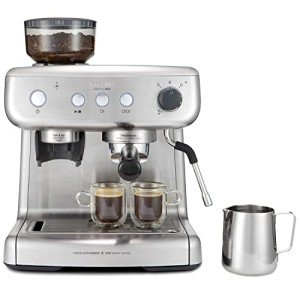This Week's Top Stories About Italian Espresso Machines Italian Espresso Machines
Heat Exchange Espresso Machines: A Comprehensive Guide
Espresso machines have evolved significantly over the years, dealing with the needs of home baristas and coffee specialists alike. Amongst these machines, heat exchange espresso machines have acquired appeal due to their capability to deliver constant efficiency and extraordinary brew quality. In this post, we will check out the operations, advantages, and important features of heat exchange espresso machines, supplying an extensive understanding for both possible purchasers and coffee enthusiasts.
Comprehending Heat Exchange Technology
Heat exchange espresso machines operate on a distinct concept that allows synchronised water heating for developing and steaming. Manual Espresso Machines are geared up with a single boiler that uses a heat exchanger system. This feature is considerable as it allows users to brew espresso while steaming milk simultaneously, promoting effectiveness in the coffee-making procedure.
How Does a Heat Exchange Espresso Machine Work?
The procedure starts with the machine's water inlet filling the boiler. As the water heats up, it turns to steam. The ingenious heat exchanger uses hot steam to heat additional water in a different passage developed particularly for the brew group. This means that water can reach the perfect brewing temperature without awaiting the boiler to adjust. The crucial steps include:
- Water Fill: Water is drawn into the boiler.
- Heating Process: The boiler heats up as water is transformed into steam.
- Heat Exchange: Steam heats up water in the heat exchanger tube.
- Brewing: Water from the heat exchanger is pushed through coffee grounds, extracting the flavors required for an abundant espresso.
This process enables fast temperature level adjustments and enhanced coffee extraction.
Benefits of Heat Exchange Espresso Machines
Heat exchange espresso machines use numerous advantages, especially for those wanting to maximize their coffee experience. Here are some essential advantages:
- Simultaneous Brewing and Steaming: Users can brew espresso while steaming milk, making it perfect for busy cafes and home baristas who value performance.
- Temperature Stability: The boiler's steam pressure helps maintain a stable temperature, which is critical for consistent espresso extraction.
- Adaptability: The style enables fast changing between developing and steaming, making it simpler to produce various coffee beverages, from lattes to cappuccinos.
- User-friendly: Models frequently include available controls, making it possible for both beginners and skilled baristas to produce quality drinks.
- Professional Quality: Heat exchange machines are often utilized in commercial settings, offering users with high-quality brewing efficiency in your home.
Secret Features to Look for in Heat Exchange Espresso Machines
When thinking about the purchase of a heat exchange espresso machine, there are several functions that one need to take into consideration:
- Build Quality: Look for machines made from resilient materials, such as stainless-steel or brass, ensuring durability.
- Boiler Size: A larger boiler will hold more water and sustain greater output with time.
- PID Temperature Control: This function assists maintain consistent brew temperatures, which can improve the coffee-making procedure.
- Group Head Design: Machines with a saturated or semi-saturated group head offer better temperature stability.
- Ease of Use: User-friendly user interfaces and user-friendly controls boost the overall experience for baristas at all skill levels.
- Steam Wand Quality: A good steam wand with appropriate insulation and flexibility permits better texturing of milk.
- Water Reservoir Size: Depending on your requirements, think about how frequently you want to fill up the water tank.
Comparison of Popular Heat Exchange Espresso Machines
To better understand the options available in the market, below is a comparison table of some popular heat exchange espresso machines:
Machine Model
Boiler Size
PID Control
Price Range
User Ratings
Profitec Pro 700
2.0 L
Yes
₤ 2,000-₤ 2,500
9.5/ 10
Rocket Espresso R58
1.8 L
Yes
₤ 2,400-₤ 2,800
9.4/ 10
Elekta Bianca
1.8 L
Yes
₤ 2,500-₤ 3,000
9.6/ 10
La Spaziale S1 Vivaldi II
1.5 L
Yes
₤ 1,800-₤ 2,200
9.2/ 10
Bezzera Magica
1.2 L
No
₤ 1,600-₤ 1,800
9.0/ 10
Frequently Asked Questions About Heat Exchange Espresso Machines
What is the main distinction between a heat exchange and a dual boiler espresso machine?
While both types can brew espresso and steam milk at the exact same time, dual boiler machines have different boilers for brewing and steaming. On the other hand, heat exchange machines make use of a single boiler and a heat exchanger to achieve the very same function.
Are heat exchange machines ideal for beginners?
Yes! Numerous heat exchange machines are developed with user-friendly features, making them available for novices. With Manual Espresso Machines and practice, users can rapidly produce quality espresso.
What sort of maintenance do heat exchange espresso machines need?
Regular maintenance includes descaling, cleaning the boiler, inspecting seals and gaskets, and keeping the group head tidy. Routine upkeep guarantees longevity and constant performance.
Can I use a heat exchange machine for different kinds of coffee beverages?
Definitely! Heat exchange machines enable users to produce a range of coffee drinks, consisting of espresso, lattes, cappuccinos, and more.
Heat exchange espresso machines represent a mix of development and custom, supplying coffee lovers with the tools needed for crafting the ideal cup. Their ability to concurrently brew and steam, integrated with exact temperature control, makes them an engaging choice for both home baristas and specialists. With the right knowledge on features and maintenance, users can open a world of elegant coffee experiences, making sure that each sip is as delightful as the last.
